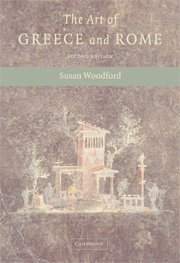Book contents
- Frontmatter
- Contents
- List of Illustrations
- Acknowledgements
- Maps
- Introduction
- PART I THE ARCHAIC AND CLASSICAL PERIODS: PROGRESS AND PROBLEMS
- PART II THE FOURTH CENTURY BC AND THE HELLENISTIC PERIOD: INNOVATION AND RENOVATION
- PART III THE ROMAN WORLD: ADOPTION AND TRANSFORMATION OF THE GREEK LEGACY
- 7 Roman Statues and Reliefs
- 8 Roman Painting
- 9 Roman Architecture: Adaptation and Evolution
- 10 World Rulers
- Epilogue
- Appendix: How We Know What We Think We Know
- Glossary
- Further reading
- Index
7 - Roman Statues and Reliefs
- Frontmatter
- Contents
- List of Illustrations
- Acknowledgements
- Maps
- Introduction
- PART I THE ARCHAIC AND CLASSICAL PERIODS: PROGRESS AND PROBLEMS
- PART II THE FOURTH CENTURY BC AND THE HELLENISTIC PERIOD: INNOVATION AND RENOVATION
- PART III THE ROMAN WORLD: ADOPTION AND TRANSFORMATION OF THE GREEK LEGACY
- 7 Roman Statues and Reliefs
- 8 Roman Painting
- 9 Roman Architecture: Adaptation and Evolution
- 10 World Rulers
- Epilogue
- Appendix: How We Know What We Think We Know
- Glossary
- Further reading
- Index
Summary
THE EMERGENCE OF THE ROMAN EMPIRE
We have already met the Romans several times in this book. We know they were great admirers of Greek art and ordered copies of sculptures and paintings which, in some cases, give us the only information we have about celebrated Greek originals (Figs. 20, 25, 31 and 32; 72, 74, 75 and 81; 83–86; 104 and 105).
The city of Rome had begun in a small way in the 8th century bc. By the 4th century bc it had already established a republican form of government and begun the inexorable growth that was eventually to make it the centre of a vast empire.
Encounters with the Greeks began in earnest in the 3rd century bc in southern Italy and Sicily, where Greeks had long established colonies. Roman admiration for the Greeks was soon tempered by irritation as rival Hellenistic powers began to call on Rome to assist them in their struggles, for the Hellenistic kings were as frequently at war with one another as the classical poleis had been. The Romans were militarily better organised than the Greeks and politically more efficient. When their patience ran out with the endlessly squabbling Greeks, they began to subjugate the Hellenistic kingdoms one by one. The last to fall was Egypt, conquered by Augustus in 31 bc. At the same time, the republic vanished, leaving only a handful of traditional forms.
- Type
- Chapter
- Information
- The Art of Greece and Rome , pp. 89 - 100Publisher: Cambridge University PressPrint publication year: 2004



